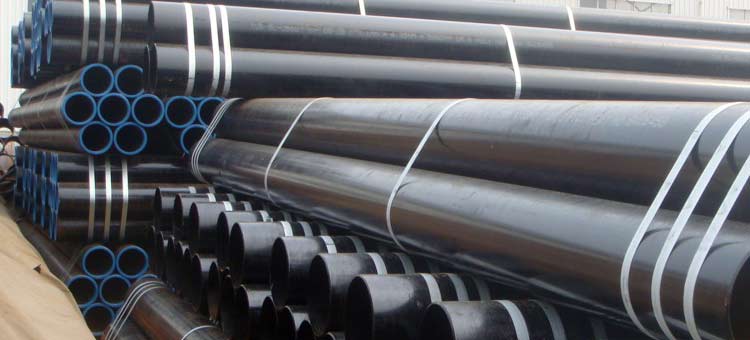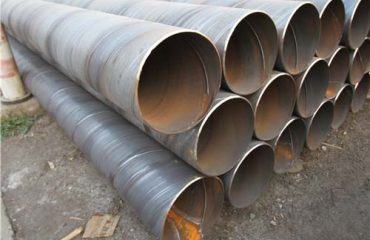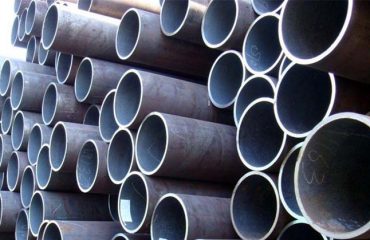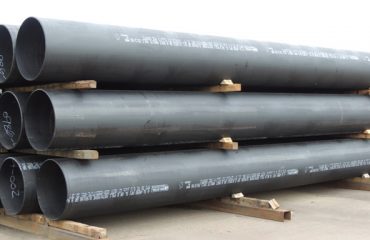
ASTM A672 اللحام الكهربائي (افو) أنابيب الصلب
مقدمة
ASTM A672 هي مواصفات تغطي اللحام الكهربائي بالانصهار (افو) أنابيب فولاذية مصممة لخدمة الضغط العالي في درجات حرارة معتدلة. تستخدم هذه الأنابيب بشكل شائع في صناعات مثل توليد الطاقة, البتروكيماويات, النفط والغاز, ونقل المياه. توفر المواصفات إرشادات للتصنيع, اختبار, وفحص الأنابيب الفولاذية للتأكد من استيفائها للخصائص الميكانيكية اللازمة ومتطلبات الأداء لتطبيقات الضغط العالي.
عملية EFW هي طريقة لحام تستخدم القوس الكهربائي لدمج الألواح الفولاذية معًا, تشكيل التماس الطولي. تتميز هذه العملية بالكفاءة العالية وتنتج أنابيب تتمتع بسلامة هيكلية وقوة ميكانيكية ممتازة. تتوفر أنابيب ASTM A672 بدرجات مختلفة بناءً على نوع الفولاذ المستخدم والخواص الميكانيكية المطلوبة.
هذه المقالة سوف تستكشف عملية التصنيع, الخصائص الميكانيكية, وتطبيقات الأنابيب الفولاذية ASTM A672 EFW, وكذلك طرق الاختبار المستخدمة للتأكد من وجودها جودة والأداء.
جدول المحتويات
- ما هو ASTM A672 EFW أنابيب الصلب?
- عملية تصنيع الأنابيب الفولاذية ASTM A672 EFW
- لحام الانصهار الكهربائي (افو) عملية
- المعالجة بالحرارة
- درجات وفئات أنابيب الصلب ASTM A672
- الخواص الميكانيكية لأنابيب الصلب ASTM A672 EFW
- متطلبات الاختبار والتفتيش
- اختبار غير تدميري (NDT)
- الاختبار الهيدروستاتيكي
- تطبيقات أنابيب الصلب ASTM A672 EFW
- أسئلة مكررة (التعليمات)
- استنتاج
ما هو ASTM A672 EFW أنابيب الصلب? {#ما هي الأنابيب الفولاذية ASTM-A672-EFW}
ASTM A672 هي مواصفات قياسية للحام الانصهار الكهربائي (افو) أنابيب فولاذية مصممة لخدمة الضغط العالي في درجات حرارة معتدلة. يتم تصنيع هذه الأنابيب من أوعية الضغط جودة صفائح فولاذية ملحومة باستخدام القوس الكهربائي. تغطي المواصفة الأنابيب ذات التماس الطولي وهي مخصصة للاستخدام في التطبيقات التي تتطلب قوة ومتانة عالية.
الميزات الرئيسية لأنابيب الصلب ASTM A672 EFW:
-
الانصهار الكهربائي الملحومة (افو): يتم تصنيع الأنابيب باستخدام عملية EFW, والتي تتضمن دمج الألواح الفولاذية معًا باستخدام قوس كهربائي. تنتج هذه العملية لحامًا طوليًا قويًا يمكنه تحمل الضغوط العالية.
-
وعاء الضغط جودة صلب: تتميز الألواح الفولاذية المستخدمة في تصنيع أنابيب ASTM A672 بجودة أوعية الضغط, مما يعني أنها مصممة لتحمل الضغوط الداخلية العالية دون فشل.
-
خدمة الضغط العالي: أنابيب ASTM A672 مناسبة لتطبيقات الضغط العالي, مثل الغلايات, المبادلات الحرارية, وخطوط الأنابيب في صناعة النفط والغاز.
-
تطبيقات درجة الحرارة المعتدلة: تغطي المواصفات الأنابيب المصممة للاستخدام في درجات حرارة معتدلة, عادة تصل إلى 400 درجة مئوية (752F).
-
درجات مختلفة: تتوفر أنابيب ASTM A672 بدرجات مختلفة بناءً على نوع الفولاذ المستخدم والخواص الميكانيكية المطلوبة. يتم تحديد الدرجات من خلال التركيب الكيميائي والمعالجة الحرارية للصلب.
عملية تصنيع الأنابيب الفولاذية ASTM A672 EFW {#عملية تصنيع الأنابيب الفولاذية astm-a672-efw}
يتضمن تصنيع الأنابيب الفولاذية ASTM A672 EFW عدة خطوات, بما في ذلك اختيار ألواح فولاذية عالية الجودة لأوعية الضغط, اللحام الانصهار الكهربائي (افو) عملية, والمعالجة الحرارية لتحقيق الخواص الميكانيكية المطلوبة.
لحام الانصهار الكهربائي (افو) عملية {#عملية اللحام بالانصهار الكهربائي}
عملية EFW هي نوع من اللحام القوسي الذي يستخدم قوسًا كهربائيًا لدمج الألواح الفولاذية معًا على طول خط التماس الطولي. تتضمن العملية الخطوات التالية:
-
إعداد اللوحة: يتم أولاً قطع الألواح الفولاذية إلى الأبعاد المطلوبة وفحصها بحثًا عن أي عيوب أو عيوب سطحية.
-
تحضير الحافة: حواف الصفائح الفولاذية مشطوفة لضمان الالتحام المناسب أثناء عملية اللحام. يتم التحكم في الزاوية المائلة بعناية لتحقيق لحام قوي.
-
لحام الانصهار الكهربائي: يتم وضع اللوحات من الحافة إلى الحافة, ويستخدم القوس الكهربائي لإذابة حواف الصفائح, إنشاء تجمع اللحام. كما يتحرك القوس على طول التماس, يصلب المعدن المنصهر, تشكيل لحام مستمر على طول الأنبوب.
-
فحص اللحام: يتم فحص اللحام بحثًا عن عيوب مثل المسامية, الشقوق, أو اندماج غير كامل. اختبار غير مدمر (NDT) طرق, مثل اختبار الموجات فوق الصوتية أو اختبار التصوير الشعاعي, غالبا ما تستخدم لضمان جودة اللحام.
-
التحجيم والتشكيل: بعد اللحام, يتم تمرير الأنبوب من خلال سلسلة من البكرات لتحقيق القطر والاستدارة المطلوبة. يتم أيضًا فحص الأنبوب للتأكد من دقة الأبعاد.
المعالجة بالحرارة {#المعالجة الحرارية}
بعد عملية EFW, قد تخضع الأنابيب للمعالجة الحرارية لتحسين خواصها الميكانيكية وتخفيف الضغوط المتبقية الناتجة أثناء اللحام. يعتمد نوع المعالجة الحرارية على درجة الفولاذ ومتطلبات التطبيق. تشمل عمليات المعالجة الحرارية الشائعة:
-
التطبيع: يتم تسخين الأنبوب إلى درجة حرارة أعلى من النقطة الحرجة ثم يتم تبريده في الهواء. تعمل هذه العملية على تحسين بنية الحبوب وتحسين صلابة الفولاذ.
-
التبريد والتلطيف: يتم تسخين الأنبوب إلى درجة حرارة عالية ثم يتم تبريده بسرعة (مروي) في الماء أو الزيت. ثم يتم إعادة تسخينه إلى درجة حرارة أقل (خفف) لتحسين ليونة وصلابتها.
-
تخفيف التوتر: يتم تسخين الأنبوب إلى درجة حرارة معتدلة ثم يتم تبريده ببطء لتخفيف الضغوط المتبقية دون تغيير الخواص الميكانيكية بشكل كبير.
درجات وفئات أنابيب الصلب ASTM A672 {#الدرجات والفئات من الأنابيب الفولاذية astm-a672}
تتوفر الأنابيب الفولاذية ASTM A672 بدرجات وفئات مختلفة بناءً على نوع الفولاذ المستخدم والخواص الميكانيكية المطلوبة. يتم تحديد الدرجات من خلال التركيب الكيميائي للصلب, بينما تعتمد الفصول على متطلبات المعالجة الحرارية والاختبار.
الدرجات المشتركة:
-
الصف B60: هذا الصف مصنوع من الفولاذ الكربوني مع الحد الأدنى من قوة الشد 415 الآلام والكروب الذهنية (60,000 هذه المبادرة). يستخدم عادة لتطبيقات الضغط المعتدل.
-
الصف C65: هذا الصف مصنوع من الفولاذ الكربوني والمنغنيز مع قوة شد لا تقل عن 450 الآلام والكروب الذهنية (65,000 هذه المبادرة). إنها مناسبة لتطبيقات الضغط العالي.
-
الصف C70: هذا الصف مصنوع من الفولاذ الكربوني والمنغنيز مع قوة شد لا تقل عن 485 الآلام والكروب الذهنية (70,000 هذه المبادرة). يتم استخدامه في تطبيقات الضغط العالي حيث تكون القوة والمتانة أمرًا بالغ الأهمية.
فصول:
- صف دراسي 10: يتم توفير الأنابيب في هذه الفئة في حالة ملحومة دون أي معالجة حرارية.
- صف دراسي 12: تتم معالجة الأنابيب في هذه الفئة بالحرارة بعد اللحام لتحسين خواصها الميكانيكية وتخفيف الضغوط المتبقية.
- صف دراسي 22: تخضع الأنابيب في هذه الفئة للتبريد والتلطيف لتحقيق قوة وصلابة أعلى.
مواصفات المواد {#مواصفات المواد}
أستم A672 تصنع الأنابيب من ألواح فولاذية عالية الجودة لأوعية الضغط التي يتم لحامها باستخدام لحام الانصهار الكهربائي (افو) عملية. المواصفات تغطي الأنابيب في مختلف الدرجات و فصول, والتي يحددها التركيب الكيميائي من الفولاذ و المعالجة بالحرارة يتم تطبيقه بعد اللحام.
الميزات الرئيسية لأنابيب الصلب ASTM A672 EFW:
- الانصهار الكهربائي الملحومة (افو): يتم لحام الأنابيب باستخدام قوس كهربائي لدمج ألواح الصلب, إنشاء أ اللحام الطولي.
- الفولاذ عالي الجودة لأوعية الضغط: الألواح الفولاذية المستخدمة هي من جودة أوعية الضغط, ضمان قدرة الأنابيب على الصمود الضغوط الداخلية العالية.
- خدمة الضغط العالي: تم تصميم أنابيب ASTM A672 من أجل تطبيقات الضغط العالي في درجات حرارة معتدلة.
- الدرجات والطبقات: توفر المواصفات متعددة الدرجات و فصول على أساس التركيب الكيميائي و المعالجة بالحرارة من الفولاذ.
جدول التركيب الكيميائي {#جدول التركيب الكيميائي}
يختلف التركيب الكيميائي للأنابيب الفولاذية ASTM A672 اعتمادًا على الصف من الفولاذ المستخدم. يوضح الجدول أدناه التركيب الكيميائي النموذجي للدرجات الشائعة المستخدمة في أنابيب ASTM A672.
| عنصر | الصف B60 (%) | الصف C65 (%) | الصف C70 (%) |
|---|---|---|---|
| كربون (ج) | 0.26 ماكس | 0.24 ماكس | 0.23 ماكس |
| المنغنيز (مينيسوتا) | 0.98 ماكس | 1.20 ماكس | 1.35 ماكس |
| الفوسفور (ف) | 0.035 ماكس | 0.035 ماكس | 0.035 ماكس |
| الكبريت (S) | 0.035 ماكس | 0.035 ماكس | 0.035 ماكس |
| السيليكون (الاشتراكية الدولية) | 0.13-0.45 | 0.13-0.45 | 0.13-0.45 |
| الكروم (الجمهورية التشيكية) | 0.30 ماكس | 0.30 ماكس | 0.30 ماكس |
| النيكل (ني) | 0.30 ماكس | 0.30 ماكس | 0.30 ماكس |
| الموليبدينوم (مو) | 0.12 ماكس | 0.12 ماكس | 0.12 ماكس |
| النحاس (الاتحاد الجمركي) | 0.40 ماكس | 0.40 ماكس | 0.40 ماكس |
| الفاناديوم (V) | 0.08 ماكس | 0.08 ماكس | 0.08 ماكس |
وتلاحظ:
- محتوى الكربون يعد عاملا أساسيا في تحديد قوة و صلابة من الفولاذ. يتحسن محتوى الكربون المنخفض قابلية اللحام و ليونة.
- المنغنيز يحسن مقاومة الشد و الصلابة من الفولاذ.
- الفوسفور و الكبريت يتم الاحتفاظ بها عند مستويات منخفضة لمنع هشاشة و تحسين المتانة.
- السيليكون بمثابة مزيل الأكسدة أثناء عملية صناعة الصلب ويحسن قوة.
جدول الخواص الميكانيكية {#جدول الخصائص الميكانيكية}
يتم تحديد الخواص الميكانيكية للأنابيب الفولاذية ASTM A672 بواسطة الصف و صف دراسي من الأنبوب, وكذلك المعالجة بالحرارة يتم تطبيقه بعد اللحام. يوفر الجدول أدناه الخواص الميكانيكية النموذجية للدرجات الشائعة لأنابيب ASTM A672.
| ملكية | الصف B60 | الصف C65 | الصف C70 |
|---|---|---|---|
| مقاومة الشد (الآلام والكروب الذهنية) | 415 دقيقة (60,000 هذه المبادرة) | 450 دقيقة (65,000 هذه المبادرة) | 485 دقيقة (70,000 هذه المبادرة) |
| مقاومة الخضوع (الآلام والكروب الذهنية) | 240 دقيقة (35,000 هذه المبادرة) | 275 دقيقة (40,000 هذه المبادرة) | 275 دقيقة (40,000 هذه المبادرة) |
| استطالة (%) | 22 دقيقة | 22 دقيقة | 22 دقيقة |
| صلابة التأثير (ي) | يختلف حسب الطبقة | يختلف حسب الطبقة | يختلف حسب الطبقة |
وتلاحظ:
- مقاومة الشد هو أقصى ضغط يمكن أن تتحمله المادة قبل أن تنكسر.
- مقاومة الخضوع هو الضغط الذي تبدأ عنده المادة بالتشوه من الناحية البلاستيكية.
- استطالة هو مقياس ليونة المادة, مما يشير إلى مقدار ما يمكن أن يمتد قبل أن ينكسر.
- صلابة التأثير يتم قياسه عادة باستخدام اختبارات شاربي على شكل حرف V, وخاصة بالنسبة للتطبيقات في البيئات ذات درجات الحرارة المنخفضة.
متطلبات الاختبار والتفتيش {#متطلبات الاختبار والتفتيش}
لضمان جودة وأداء الأنابيب الفولاذية ASTM A672 EFW, يتم استخدام العديد من طرق الاختبار والفحص أثناء عملية التصنيع. تساعد هذه الاختبارات على تحديد أي عيوب أو تناقضات في المادة أو اللحام والتي يمكن أن تؤثر على الخواص الميكانيكية للأنبوب أو سلامته الهيكلية.
اختبار غير تدميري (NDT) {#اختبار غير مدمر-ndt}
اختبار غير تدميري (NDT) يتم استخدام الطرق لفحص وصلة اللحام وجسم الأنبوب بحثًا عن العيوب دون الإضرار بالمادة. تشمل طرق NDT الشائعة:
-
اختبار بالموجات فوق الصوتية (OUT): تستخدم الموجات فوق الصوتية للكشف عن العيوب الداخلية مثل الشقوق, الفراغات, أو الانصهار غير الكامل في جسم اللحام أو الأنبوب.
-
الاختبار الشعاعي (RT): يتم استخدام الأشعة السينية أو أشعة جاما لإنشاء صورة للحام, مما يسمح للمفتشين بتحديد العيوب الداخلية مثل المسامية, شوائب الخبث, أو الشقوق.
-
اختبار الجسيمات المغناطيسية (MT): تستخدم هذه الطريقة للكشف عن العيوب السطحية في المواد المغناطيسية. يتم تطبيق المجال المغناطيسي على الأنبوب, وتستخدم جزيئات الحديد للكشف عن أي شقوق أو انقطاعات على السطح.
-
صبغ اختبار توغل (PT): يتم تطبيق صبغة على سطح الأنبوب, وأي شقوق أو عيوب سوف تمتص الصبغة, مما يجعلها مرئية تحت الضوء فوق البنفسجي.
الاختبار الهيدروستاتيكي {#الاختبار الهيدروستاتيكي}
يعد الاختبار الهيدروستاتيكي اختبارًا حاسمًا يستخدم للتأكد من قدرة الأنبوب على تحمل الضغط الداخلي الذي سيتعرض له أثناء الخدمة. خلال هذا الاختبار, يمتلئ الأنبوب بالماء ويتم ضغطه إلى مستوى أعلى من ضغط التشغيل. يتم بعد ذلك فحص الأنبوب بحثًا عن أي تسربات أو تشوهات قد تشير إلى وجود ضعف في المادة أو اللحام.
- اختبار الضغط: ضغط الاختبار عادة 1.5 أضعاف الضغط التصميمي للأنبوب.
- مدة: يتم الاحتفاظ بالأنبوب عند ضغط الاختبار لفترة محددة (عادة 5 إلى 15 دقائق) للتأكد من أنها يمكن أن تحافظ على الضغط دون الفشل.
تطبيقات أنابيب الصلب ASTM A672 EFW {#تطبيقات-ASTM-A672-EFW-الأنابيب الفولاذية}
يتم استخدام الأنابيب الفولاذية ASTM A672 EFW في مجموعة واسعة من الصناعات والتطبيقات حيث تعد خدمة الضغط العالي والسلامة الهيكلية أمرًا بالغ الأهمية. وتشمل بعض التطبيقات الشائعة:
-
توليد الطاقة: تستخدم أنابيب ASTM A672 في الغلايات, المبادلات الحرارية, وخطوط أنابيب البخار في محطات توليد الكهرباء نظراً لقدرتها على تحمل الضغوط العالية ودرجات الحرارة المعتدلة.
-
صناعة بتروكيماوية: وتستخدم هذه الأنابيب في المصافي, نباتات كيميائية, والمرافق البتروكيماوية لنقل السوائل والغازات المسببة للتآكل تحت ضغط عالٍ.
-
صناعة النفط والغاز: تستخدم أنابيب ASTM A672 في خطوط أنابيب النفط والغاز, المنصات البحرية, وخطوط الأنابيب تحت سطح البحر لنقل النفط الخام, الغاز الطبيعي, وغيرها من الهيدروكربونات.
-
نقل المياه: تستخدم هذه الأنابيب في أنظمة نقل المياه لنقل المياه الصالحة للشرب, مياه الصرف الصحي, والمياه الصناعية تحت ضغط عال.
-
التطبيقات الهيكلية: تستخدم أنابيب ASTM A672 في التطبيقات الهيكلية مثل الأعمدة, الحزم, والدعم في المباني والهياكل الصناعية حيث تتطلب القوة والمتانة.
أسئلة مكررة (التعليمات) {#التعليمات}
1. ما هو الفرق بين أنابيب EFW وERW؟?
افو (الانصهار الكهربائي الملحومة) يتم لحام الأنابيب باستخدام قوس كهربائي لدمج الألواح الفولاذية معًا, بينما المتفجرات من مخلفات الحرب (المقاومة الكهربائية الملحومة) يتم لحام الأنابيب باستخدام المقاومة الكهربائية لتسخين حواف الفولاذ ودمجها معًا. تُستخدم أنابيب EFW عادةً في تطبيقات الضغط العالي, بينما تستخدم أنابيب المتفجرات من مخلفات الحرب لتطبيقات الضغط المنخفض إلى المتوسط.
2. ما هي الدرجات المشتركة لأنابيب ASTM A672?
تشمل الدرجات الشائعة لأنابيب ASTM A672 الدرجة B60, الصف C65, والصف C70, والتي تعتمد على التركيب الكيميائي والخواص الميكانيكية للصلب.
3. ما هي درجة حرارة التشغيل القصوى لأنابيب ASTM A672؟?
تم تصميم أنابيب ASTM A672 للاستخدام في درجات حرارة معتدلة, عادة تصل إلى 400 درجة مئوية (752F), اعتمادا على درجة وفئة الأنبوب.
4. كيف يتم ضمان جودة أنابيب ASTM A672?
يتم ضمان جودة أنابيب ASTM A672 من خلال الاختبارات غير المدمرة (NDT) طرق مثل اختبار الموجات فوق الصوتية, الاختبار الشعاعي, واختبار الجسيمات المغناطيسية, بالإضافة إلى الاختبار الهيدروستاتيكي للتحقق من قدرة الأنبوب على تحمل الضغط الداخلي.
5. ما هي الصناعات التي تستخدم الأنابيب الفولاذية ASTM A672 EFW?
يتم استخدام الأنابيب الفولاذية ASTM A672 EFW في صناعات مثل توليد الطاقة, البتروكيماويات, النفط والغاز, ونقل المياه نظراً لقدرتها على تحمل الضغوط العالية ودرجات الحرارة المعتدلة.
استنتاج {#استنتاج}
تم تصميم الأنابيب الفولاذية ASTM A672 EFW لخدمة الضغط العالي في درجات حرارة معتدلة, مما يجعلها مثالية للاستخدام في صناعات مثل توليد الطاقة, البتروكيماويات, النفط والغاز, ونقل المياه. اللحام الانصهار الكهربائي (افو) تضمن العملية لحامًا طوليًا قويًا يمكنه تحمل الضغوط الداخلية العالية, بينما يضمن استخدام الفولاذ عالي الجودة لأوعية الضغط أن تتمتع الأنابيب بالخصائص الميكانيكية اللازمة للتطبيقات الصعبة.
متطلبات الاختبار والفحص الموضحة في ASTM A672, بما في ذلك الاختبارات غير المدمرة والاختبار الهيدروستاتيكي, تساعد على ضمان جودة وأداء الأنابيب, مما يجعلها خيارًا موثوقًا به للتطبيقات ذات الضغط العالي والتطبيقات الهيكلية.




يجب ان تكون تسجيل الدخول لإضافة تعليق.